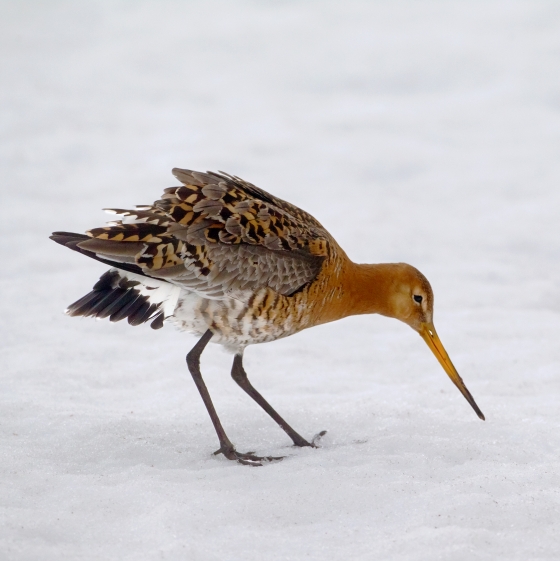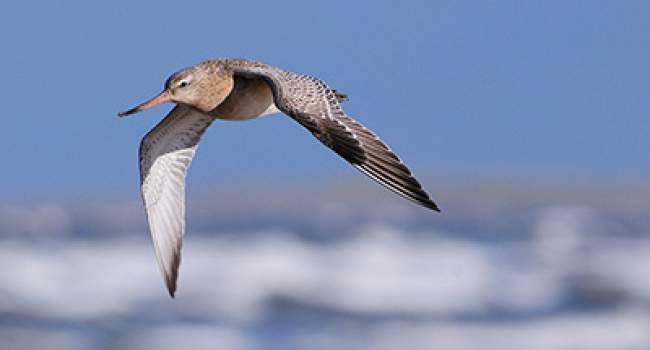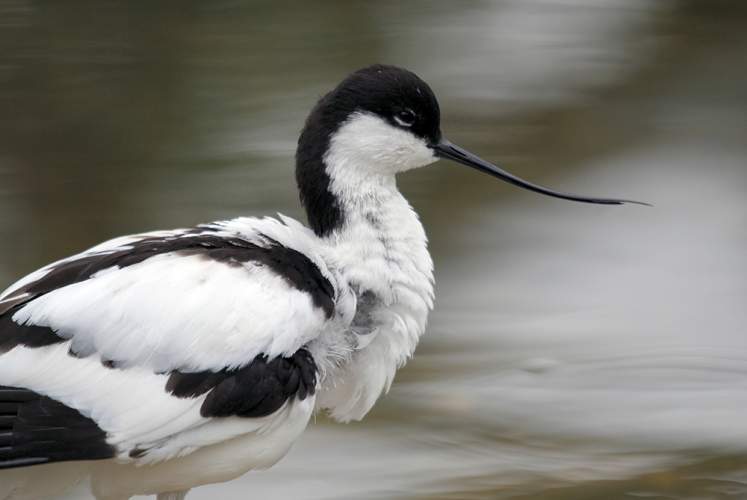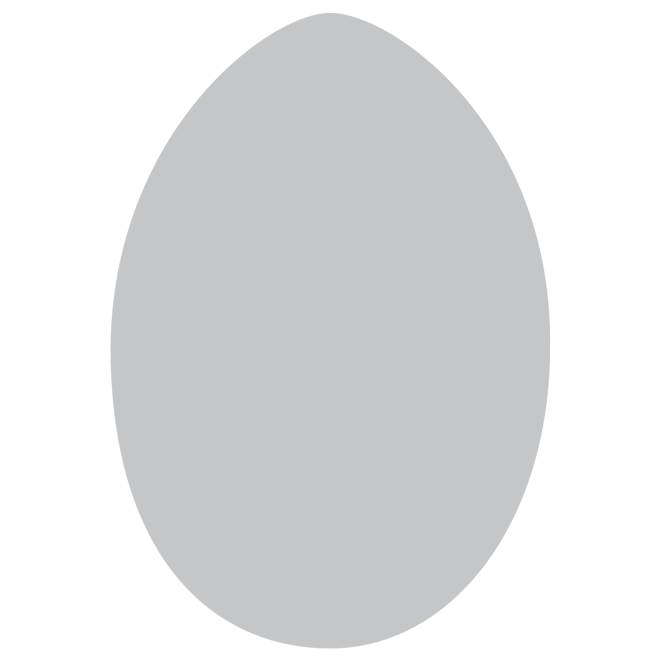Black-tailed Godwit
Limosa limosa (Linnaeus, 1758)
BW
 BLTGO
BLTGO  5320
5320

Family: Charadriiformes > Scolopacidae

This long-legged wader is more often found near freshwater than its maritime cousin, the Bar-tailed Godwit, and has plainer plumage.
A very scarce breeder, the Black-tailed Godwit is encountered in greatest numbers in the spring and autumn months as birds move south from their breeding grounds in Iceland to wintering areas in Britain, Ireland, France and Portugal. Colour-ringing has shown that whilst individuals tend to winter in the same location each year, members of each pair often winter in different countries.
While only the smallest handful of pairs now breed in Britain, WeBS counts show the no-breeding population increasingly rapidly as a result of agricultural changes in Iceland, where most of our birds come from.
Identification
Black-tailed Godwit identification is sometimes difficult. The following article may help when identifying Black-tailed Godwit.
Identifying Black-tailed and Bar-tailed Godwit

Godwits are large, elegant waders and relatively common in the right habitats at certain times of year. The two commonly encountered species, Black-tailed and Bar-tailed Godwit, should be reasonably straightforward to separate, although their eponymous tail markings may not always be the easiest feature to use! Some birds such as juveniles or out of context lone birds can prove more problematic, however, and this workshop will help you to confidently identify both species.
SONGS AND CALLS
Listen to example recordings of the main vocalisations of Black-tailed Godwit, provided by xeno-canto contributors.
Other
Alarm call
Call
Develop your bird ID skills with our training courses
Our interactive online courses are a great way to develop your bird identification skills, whether you're new to the hobby or a competent birder looking to hone your abilities.
Browse training coursesStatus and Trends
Population size and trends and patterns of distribution based on BTO surveys and atlases with data collected by BTO volunteers.
CONSERVATION STATUS
This species can be found on the following statutory and conservation listings and schedules.
POPULATION CHANGE
The Black-tailed Godwit breeding in the UK are mostly from the limosa subspecies breeding in East Anglia, with a much smaller number of pairs from the islandica subspecies also breeding in Scotland. During thefive-year period 2013–17, a mean of 46 pairs of limosa and seven pairs of islandica were recorded (RBBP data; APEP4). The numbers and range of limosa have declined over the last fifty years (Balmer et al. 2013). Numbers have remained very low but relatively stable in the 25 years to 2019, and in the five-year period 2015–2019, there was a mean of 53 breeding pairs of Black-tailed Godwits (both subspecies) (Eaton et al. 2021). However, there have recently been declines in the limosa popualtion at its main site, from 48 pairs in 2006 to 37 pairs in 2014 (Verhoeven et al. 2021).
| UK winter population |
+159% increase (1995/96 to 2020/21)  |
DISTRIBUTION
Most Black-tailed Godwits wintering in Britain & Ireland originate from the icelandica subspecies that breeds in Iceland. In winter they are found around coastlines with soft muddy shorelines and with nearby wet grasslands. A significant number also winter around inland wetland grassland systems such as the Ouse Washes. In contrast, the small breeding population is mostly of the nominate limosa subspecies. The Ouse and Nene Washes in East Anglia remain the centre of the British breeding population. Outlying breeding records in northern Scotland may relate to extralimital icelandica breeders.
Occupied 10-km squares in UK
| No. occupied in breeding season | 40 |
| % occupied in breeding season | 1.3 |
| No. occupied in winter | 467 |
| % occupied in winter | 15 |
European Distribution Map
DISTRIBUTION CHANGE
The Icelandic breeding population has undergone a sustained breeding population increase, resulting in a long-term increase in the numbers wintering in Britain and Ireland and a concurrent range expansion.
Change in occupied 10-km squares in the UK
| % change in range in breeding season (1968–72 to 2008–11) | -7% |
| % change in range in winter (1981–84 to 2007–11) | +171.4% |
SEASONALITY
Black-tailed Godwits are recorded throughout the year with a strong peak in autumn migration.

Movement
Information about movement and migration based on online bird portals (e.g. BirdTrack), Ringing schemes and tracking studies.
An overview of year-round movements for the whole of Europe can be seen on the EuroBirdPortal viewer.
RINGING RECOVERIES
View a summary of recoveries in the Online Ringing Report.
Foreign locations of birds ringed or recovered in Britain & Ireland

Biology
Lifecycle and body size information about Black-tailed Godwit, including statistics on nesting, eggs and lifespan based on BTO ringing and nest recording data.
SURVIVAL & LONGEVITY
View number ringed each year in the Online Ringing Report
Maximum Age from Ringing 
|
23 years 3 months 21 days (set in 2001) 
|
Typical Lifespan 
|
18 years with breeding typically at 2 year |
Adult Survival 
|
0.94±0.02  
|
BIOMETRICS
Wing Length 
|
Adults | 215.6±8.4 | Range 201–231mm, N=59 |
| Juveniles | 215.4±10.8 | Range 202-229mm, N=78 |
Body Weight 
|
Adults | 299±39.67 | Range 240–360g, N=48 |
| Juveniles | 282±36.8495 | Range 218–345g, N=59 |
Feather measurements and photos on featherbase 
CODES & CLASSIFICATION
Ring size 
|
E or D2 (pulli E) |
Field Codes 
|
2-letter: BW | 5-letter code: BLTGO | Euring: 5320 |
For information in another language (where available) click on a linked name
Research
Interpretation and scientific publications about Black-tailed Godwit from BTO scientists.
CAUSES AND SOLUTIONS
Causes of change
The limosa subspecies is also declining in continental Europe and there is good evidence that the main driver of the declines is poor productivity due to agricultural intensification (Gill et al. 2007). Recent declines ofthe limosa population have been attributed to low breeding productivity resulting from an increase in predation pressure (Verhoeven et al. 2021). Intensive conservation efforts are being undertaken to manage the species at its remaining sites including 'head-starting', i.e. taking eggs and raising the resulting young in captivity before releasing them in the wild, in order to increase breeding productivity (Eaton et al. 2021; see also Project Godwit website for further info; https://projectgodwit.org.uk).
PUBLICATIONS (2)
Black-tailed Godwits on the Wash

Consequences of population change for local abundance and site occupancy of wintering waterbirds
Wavering Waterbirds
Protected sites are assigned based on population statistics for vulnerable and endangered species. This new study using WeBS data shows that changes in population size can affect local abundance, and thus influence whether or not key targets are met for site protection.
Links to more information from ConservationEvidence.com
Would you like to search for another species?














Share this page